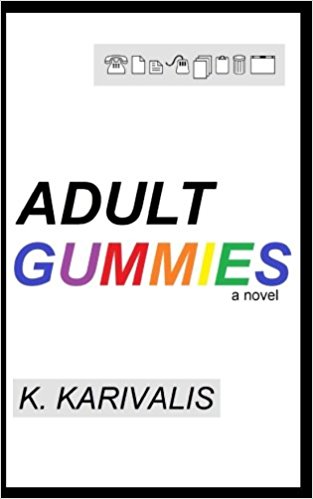
Neon Burrito Publishing, 2018
A Reviewable Feast is a hybrid book review/author interview series by Mandy Shunnarah.
__
“I saw the best minds of my generation artificially enhanced by the excessive nutrients of two-a-day adult gummy multivitamins, upgraded alongside their devices… going through the motions as the world watched, being completely aware they were being watched… every one of them pretending to work harder than the next but only as hard as will require the least amount of effort.”
With that howler of an opening, K. Karivalis begins Adult Gummies, her satirical novella on the battle between Millennials making art, making money, and often being disenchanted by both. The characters learn the hard way that office jobs can lack creative and spiritual fulfillment, while full time creative self-employment can lack steady income. In the parlance of our times, the struggle is real.
Jen, Kat, Dirk, and Thad work at the amorphous Company, a business whose goings-on we know nothing of besides content creation, advertising, and sales. Jen dreams of being the Content Queen, vying for the head copywriting position. Kat wants to be a “real writer” who’s creatively fulfilled. Dirk coasts along, not having to do much since his privilege as a white man already affords him more money and growth opportunities than Jen, his chief rival. Thad endures the indignities of daily racial microaggressions just going to and from work. Adult Gummies is sardonic social commentary at its best.
I talked to K. Karivalis about Millennial struggles, music as an escape, and the effect of personal branding on art.
Mandy Shunnarah: I’m curious about how this book came to be. Did you have an office job you hated where you ran into the real-life inspirations for the characters?
- Karivalis: I landed my first office job when I was 24 and it was at Binder & Binder (yes, the Social Security Disability law firm with ads on daytime TV) and it was bleak, like a caricature of a mundane office job. I was hired as a “writer,” which meant I wrote legal documents and had to learn all these laws about Social Security Disability, etc. The contrast between the rather alternative “artsy” lifestyle I lived the first few years after graduating college and the 9 to 5 world was jarring, almost terrifying, but in a fascinating way because it was all completely new to me. I felt like I was thrown into a movie set, like I was starring in a movie about a young woman navigating the banality of big city office life. So it felt natural to translate those experiences into a book, though I didn’t do so until a few years after I left that job. One particular character (Dirk) is very much based off of a former coworker, the others are more inspired by bits and pieces of people I know and different millennial stereotypes.
MS: One of the things I loved about Adult Gummies is that, while satirized, it’s eerily true to life for Millennials who have worked at a company that produces content. Kat says she wants to be a “real writer, not a copywriter,” and meanwhile the protagonist Jen actively wants to be a copywriter because then she’d be the Content Queen she aspires to be. And yet neither of them fit well at The Company. I imagine there are a lot of writers who feel like this right now––wondering whether they should write for the sake of creating art or write what sells, even if what sells is often substandard. How did you navigate all this? Is this dichotomy something you find yourself struggling with?
KK: The characters Kat and Jen represent this dichotomy: quit your job and pursue your writing dreams with reckless abandon or climb the ladder of being a “professional” writer in a “professional” setting, hoping that if you reach your desired position, you will be satisfied creatively while still having the comforts that 9 to 5 jobs provide. Kat’s decision to (spoiler alert) quit her job and become a “real writer” and Jen’s dedication to playing the professionalism game represent the fork in the road I feel like I am at now.
I currently work an office job but it’s part time, which gave me the time to write Adult Gummies. Before I started working on the book though, I was focused on finding a full-time professional job as a content creator and/or copywriter at a company that I thought embraced the idea of a progressive office environment and encouraged creativity, such as the Urban Outfitters corporate headquarters, which is one of the biggest employers of young creatives in Philadelphia. At the Urban Outfitters corporate headquarters, people bring their dogs to work, buildings are situated on this beautiful campus with trees and public sculptures, there are many artisan options for cruelty-free lunch, you can bring your laptop outside to work on the grass when it’s nice out––this sort of utopian idea of The New Professionalism, trying to rid office jobs of their stigma. I thought the combination of my professional experience and online “clout” (some of these jobs require a minimum amount of Instagram and/or Twitter followers) would make it easy for me to land one of these jobs, but alas, this was not the case. So I thought, ‘okay screw you I’m writing a book.’
Unfortunately, I think most young writers these days give up on The Dream and get the creative labor job and tell themselves they’ll write their novel in their spare time. But this is the climate we are in now––this is the reality of money ruling the world, in addition to health insurance, benefits, sick days, 401K, job security, etc.
About a year into working at Binder & Binder, my dad died suddenly and unexpectedly from a heart attack at the age of 54. I got the phone call at my desk at Binder & Binder (I had left my cell phone at home that day by strange coincidence), and immediately that environment was poisoned with that traumatic memory. I quit my job directly afterwards and worked odd jobs for a year while in a deep state of grieving. I slowly started to rebuild my life and got the part time office job I work now, as a kind of minimal-amount-of-money-making placeholder until I felt ready to return to full time work. After I applied to and didn’t get the creative professional jobs I thought I wanted, I got real with myself and thought: “this is all a big procrastination dance to avoid putting my nose to the grindstone and writing a book.” So then I wrote the book.
I don’t think I would have had the dedication, motivation, concentration it took to write the book if I didn’t go through this horrific experience, but something about being reminded on a ceaseless, obsessive basis of my own mortality and the finite reality of living really gave me the kick in the pants I needed!
MS: I couldn’t help noticing the subtle music references throughout the novel, which was a nice surprise. I saw some Smashing Pumpkins, Pink Floyd, and others. Tell me more about the soundtrack to the novel.
KK: Parts of the novel examine intergenerational workplace dynamics––how employees from each of the three generations of working age people in America right now (Millennials, Gen X-ers, and Baby Boomers) interact with each other on a common playing ground. During the after-work karaoke party, Jeff in Sales (Gen X-er) sings “Bullet with Butterfly Wings” by The Smashing Pumpkins and Kat visualizes him in the time period of the song, in the 90’s, when Jeff in Sales (in her mind) was young and still had hope for a non-conformist lifestyle, before he sold his soul to the 9 to 5 world. The line “Despite all my rage I’m still just a rat in a cage” is in a way the thesis for the entire novel: you can hate your job as much as you want but you’re still working the job. Are you a victim of the system or are you playing yourself? Are you staying at the job you hate because you don’t have the financial means to quit or do you just lack the guts?
I decided to feature this song through karaoke because I had attempted singing it at a karaoke night a few weeks before I wrote that scene and it was surprisingly hard to sing. It starts a cappella so I was off key for like half the song. The frustration of searching for the right note after the song already started really helped me vocally express the desperation inherent in the lyrics of the chorus. So that’s what happens to Jeff in Sales too––he’s visibly frustrated trying to sing on key and also visibly frustrated at his life situation. Not only being a rat in a cage, but a rat in a cage that can’t sing its favorite song properly.
The Pink Floyd lyric “All in all your just another brick in the wall,” has become such a widespread shared sentiment for feeling helpless and dissatisfied with capitalism and modern society that it’s a cliché. Because it is so iconic and well known, I liked playing with that lyric and having Kat write on her Tumblr “All in all you’re just another blown up pizza pocket shit-stain on the wall, the white walls, the pin-pricked cubicle walls of the proverbial Dilbert.” Offices are filled with many different types of walls, both physical (glass partition, drywall, cubicle, rows of ceiling-high filing cabinets) and, of course, metaphorical.
I also want to touch on Jen’s karaoke choice, which is “Escape” by Enrique Iglesias. This is funny in context because she sings it to freak out Dirk, singing he “can’t escape her wrath.” Kat also visualizes Jen in the time period of the song like she did Jeff in Sales, but it is 2001, so she gets into a thought spiral about 9/11. Associating Enrique with 9/11 seems absurd, but it kind of made his career. Right before 9/11 happened, Enrique released “Hero” and it was a hit. However, after 9/11 “Hero” somehow became the theme song of honoring all of the fallen heroes of 9/11, and he sang it at NYFD/NYPD memorials, even though it’s a song about a romance, not about actual life-saving heroes. So this sappy, romantic-sad pop song became the theme song for the NYFD/NYPD 9/11 heroes. It was the chosen song for New York radio DJs to remix with audio from rescuers and politicians speaking about 9/11. It just seems so bizarre thinking back on it now.
MS: I want to slap this novel into the hands of every Boomer who’s ever told me I should get a “real job” while asking me to do work for free and simultaneously telling me that my generation ruined the economy. At first, I thought Adult Gummies was about disenchantment with office life, but as the characters find out, freelancing in the gig economy can be worse. In your experience, do you think the economy Millennials have had to battle makes creating art more difficult or do you think it forces us to be even more creative?
KK: This is my hopeful optimist answer: Overcoming obstacles makes for interesting art. Financial obstacles force us to be not only more creative in our budgeting but also more driven and dedicated to the act of creating (because time is money so if you spend time making art it better be worth it, as in it better be spiritually fulfilling or at least make you look cool). Creating can still feel like an act of rebellion, it can still help us express complicated emotions and ideas that go against the status quo.
The internet art of the 2010’s is a good example: artists who lacked the money for a studio space and supplies used whatever software they had on their computer. Music too, like bedroom pop and vaporwave––that all came from people holed up in their rooms with nothing but a laptop with Garageband and guitar or midi keyboard. And as far as promotion goes, everything can be done through social media. Living paycheck to paycheck and working a terrible job that barely covers your expenses is a bleak existence. Dedicating ourselves to creating art gives us purpose and an escape from the monotony of our money-driven reality.
This is my jaded pessimist answer: That being said, there is no denying the current economy makes it much harder for us to do what we want. It’s difficult to live on a minimal income, and that’s if you’re lucky enough to have dodged accruing massive amounts of student loan debt, credit card debt, getting sick and being unable to work, supporting family members, etc.
And the attitude we get from Boomers doesn’t help either, though it has given us such glorious tone-deaf clickbait as: “Millennials Aren’t Buying Diamonds, Why?” And that whole “if Millenials stopped buying avocado toast they could buy a house” fiasco. In recent times I have seen friends who were once set on being writers and artists choose the path of a full time job with a steady income after realizing how many risks have to be taken to dedicate yourself to your creative work.
If we take the little time and money we have and throw it all into writing a book, what if nobody reads it? What if it sucks? These were constant ruminations I had before, during and after writing Adult Gummies––a lot of self-doubt, anxiety and fear of failure.
MS: Nowadays it’s not just office workers who have personal brands––even writers and other artists are often expected to have a brand as part of their creative output. What effect do you think having (or striving to have) a personal brand has on art?
KK: I think it can have a profound effect at the beginning but then becomes problematic when the artist or writer wants to do a new project differently, thus having to not only re-brand but re-brand with grace. Marketing is so important (unfortunately) to get your work noticed and most artists or writers don’t know the first thing about marketing (unfortunately).
I picked up a bit of marketing knowledge when conducting research for Jen’s character, and also through my experiences on social media. A lot of the vocabulary in Adult Gummies is the result of my own experience trying to develop a personal brand for my Instagram account. Generally posts that had a consistent “theme” and “aesthetic” would get the most likes, and at that point in time my Instagram was my only active creative outlet (before I wrote Adult Gummies), so I put a lot of heart and time into it. Then I started developing a personal brand.
Kell Casual was my fake name associated with my Instagram account and she is a character who works in a dreary office but wants her microwaveable meals to be ethically sourced! And she rates different brands of adult gummy multivitamins on Amazon and links these reviews to her Twitter! And she writes melodramatic sonnets about hating Mondays! And she needs to know, for the sake of her brand’s philosophy: How does one make something so un-cool, cool?
Developing a personal brand included targeting Kell Casual’s biggest interests. There had to be reoccurring themes, including the character arc of writing and then finishing her book (my book). Jen’s character is kind of a vamped up, more clean-cut version of Kell Casual, like how actors stay in character for a few months to prepare for an Oscar-worthy role. I did a light version of this, performative for the internet, to create a multidimensional, round character for Jen. I lived in a similar flesh to experience similar experiences. Thus writing a book about a Millennial working a mundane office job became part of the brand, and then the brand became the book, and then the book promoted itself, and then people read it and apparently it doesn’t suck.
—
Mandy Shunnarah is an Alabama-born writer now living in Columbus, Ohio. Her essays, poems, and book reviews have been published in or are forthcoming from The Citron Review, Barely South Review, Entropy Magazine, Southern Women’s Review, The Missing Slate, New Southerner Magazine, and Deep South Magazine. Read more on her website offthebeatenshelf.com.

![[PANK]](https://pankmagazine.com/wp-content/themes/pank/assets/images/pank-logo-large.png)


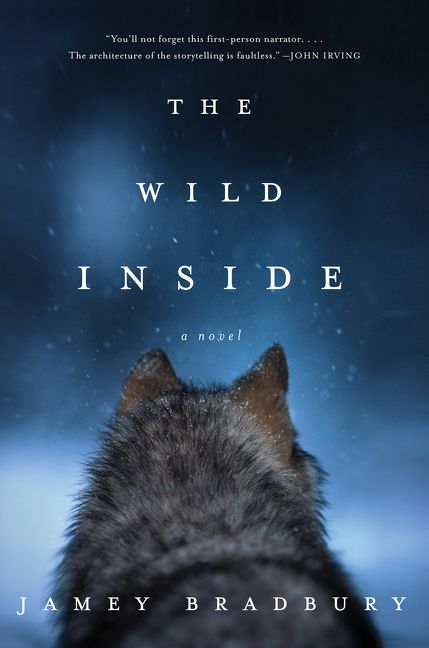


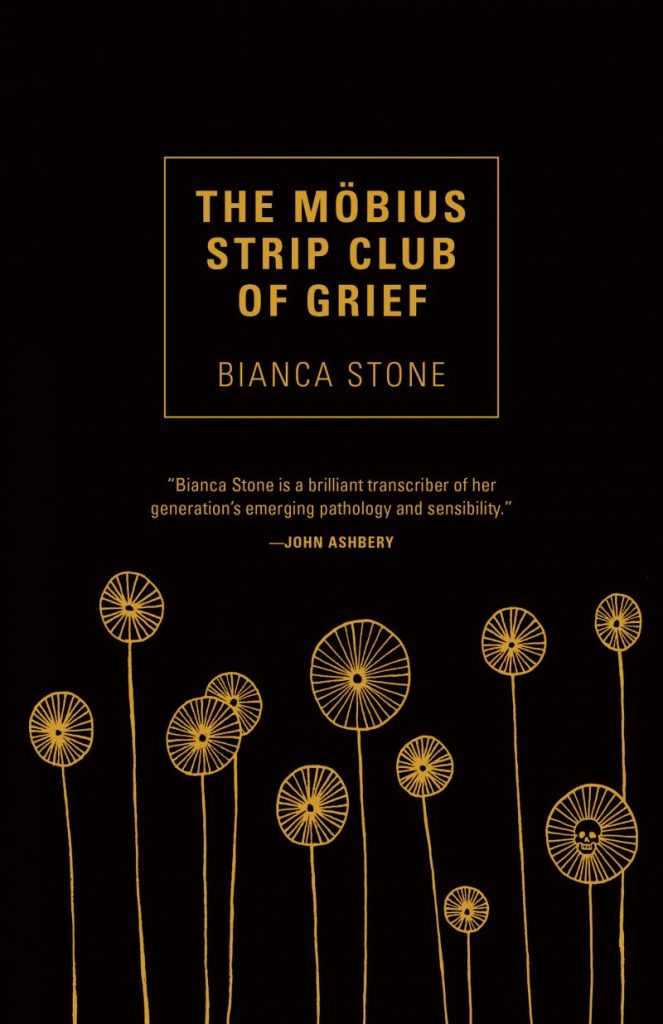
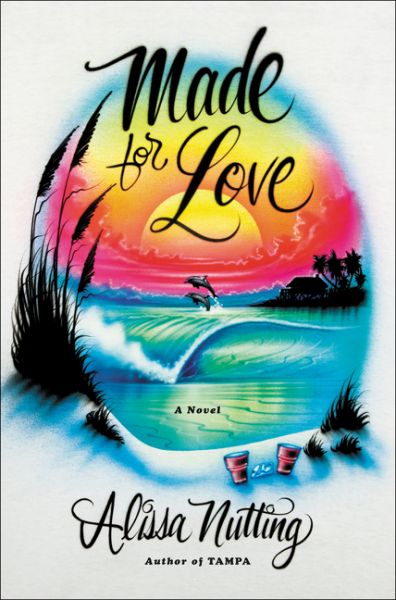
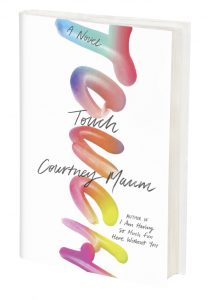 (
(